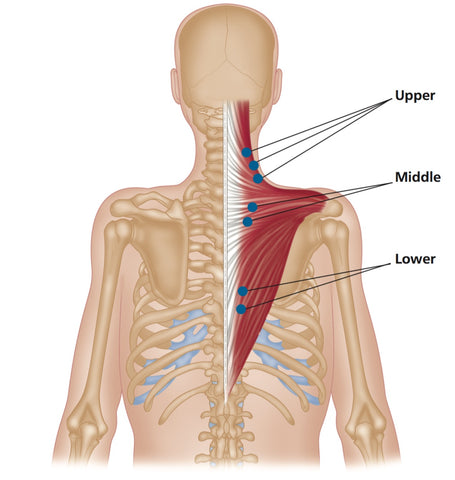Trigger Point Needling | Treating the Trapezius
Treating Trigger Points in the Trapezius Muscle - Paul Townley
The left and right trapezius viewed as a whole create a trapezium in shape, thus giving this muscle its name
As the trapezius is an important neck muscle, any spastic activity in the sternocleidomastoid, suboccipitals, scalenes, longus colli, levator scapulae, or many other muscles will have an effect on its status.
Many people hold emotional tension in the upper trapezius.
The upper portion decelerates the head, the middle portion decelerates protraction, and the lower portion decelerates shoulder elevation.
Myofascial trigger points here lead to tension headaches, with sharp pain felt in the temporal bone and into the masseter, behind the eye and ear (on the same side), and along the side of the neck.
Occasionally, pain will travel to the back of the head, and a burning pain will be experienced down into the vertebral side of the scapula and middle back.
Trapezius myofascial trigger points can cause loss of balance and dizziness.
Myofascial trigger points in this muscle are often mistaken for disc pathologies, neuralgia, spinal stenosis, shoulder bursitis, or arthritis.
Trapezius - Common Trigger Point Sites
Origin
Medial third of superior nuchal line of occipital bone. External occipital protuberance. Ligamentum nuchae. Spinous processes and supraspinous ligaments of seventh cervical vertebra (C7) and all thoracic vertebrae (T1–12).
Insertion
Posterior border of lateral third of clavicle. Medial border of acromion. Upper border of crest of spine of scapula, and tubercle on this crest.
Action
Upper fibers: pull shoulder girdle up (elevation). Help prevent depression of shoulder girdle when a weight is carried on the shoulder or in the hand.
Middle fibers: retract (adduct) scapula.
Upper and lower fibers together: rotate scapula, as in elevating the arm above the head.
Nerve
Motor supply: accessory XI nerve. Sensory supply (proprioception): ventral ramus of cervical nerves C2, 3, 4.
Basic functional movement
Example (upper and lower fibers working together): painting a ceiling.
Sports that heavily utilize this muscle
Examples: shot put, boxing, seated rowing.
Common problems when muscle is chronically tight/ shortened (spastic)
Upper fibers: neck pain or stiffness, headaches.
Trigger Point Referred Pain Patterns
Upper fibers: pain and tenderness, posterior and lateral aspect of upper neck. Temporal region and angle of jaw.
Middle fibers: local pain, radiating medially to spine.
Lower fibers: posterior cervical spine, mastoid area, area above spine of scapula.
Indications
Chronic tension and neck ache, stress headache, cervical spine pain, whiplash, tension/cluster headache, facial/jaw pain, neck pain and stiffness, upper shoulder pain, mid-back pain, dizziness, eye pain, emotional stress, depression.
Causes
Habitual postures, work, stress, neck problems, shoulder muscle weakness, use of mobiles phones / tablets, scoliosis, sports related (e.g. tennis, golf), playing musical instruments.
Differential Diagnosis
Capsular-ligamentous apparatus. Articular dysfunction (facet).
Connections
SCM, masseter, temporalis, occipitalis, levator scapulae, semispinalis, iliocostalis, clavicular part of SCM, neck/jaw/shoulder joint muscles.
Trigger Point Therapy Treatment Techniques
| Spray and Stretch | YES |
| Deep Stroking Massage | YES |
| Compression | YES |
| Muscle Energy Techniques | YES |
| Positional Release | YES |
| Dry Needling | YES |
| Wet Needling | YES |
Self help
Self massage can be very effective. Pressure tools recommended. Stretching!
General advice to patients
Posture (standing and at work). Stress management. Bra straps. Pectoralis minor tension (round shoulders). Stretch!
This trigger point therapy blog is intended to be used for information purposes only and is not intended to be used for medical diagnosis or treatment or to substitute for a medical diagnosis and/or treatment rendered or prescribed by a physician or competent healthcare professional. This information is designed as educational material, but should not be taken as a recommendation for treatment of any particular person or patient. Always consult your physician if you think you need treatment or if you feel unwell.
About Niel Asher Education
Niel Asher Education (NAT Global Campus) is a globally recognised provider of high-quality professional learning for hands-on health and movement practitioners. Through an extensive catalogue of expert-led online courses, NAT delivers continuing education for massage therapists, supporting both newly qualified and highly experienced professionals with practical, clinically relevant training designed for real-world practice.
Beyond massage therapy, Niel Asher Education offers comprehensive continuing education for physical therapists, continuing education for athletic trainers, continuing education for chiropractors, and continuing education for rehabilitation professionals working across a wide range of clinical, sports, and wellness environments. Courses span manual therapy, movement, rehabilitation, pain management, integrative therapies, and practitioner self-care, with content presented by respected educators and clinicians from around the world.
Known for its high production values and practitioner-focused approach, Niel Asher Education emphasises clarity, practical application, and professional integrity. Its online learning model allows practitioners to study at their own pace while earning recognised certificates and maintaining ongoing professional development requirements, making continuing education accessible regardless of location or schedule.
Through partnerships with leading educational platforms and organisations worldwide, Niel Asher Education continues to expand access to trusted, high-quality continuing education for massage therapists, continuing education for physical therapists, continuing education for athletic trainers, continuing education for chiropractors, and continuing education for rehabilitation professionals, supporting lifelong learning and professional excellence across the global therapy community.

Continuing Professional Education
Looking for Massage Therapy CEUs, PT and ATC continuing education, chiropractic CE, or advanced manual therapy training? Explore our evidence-based online courses designed for hands-on professionals.



















